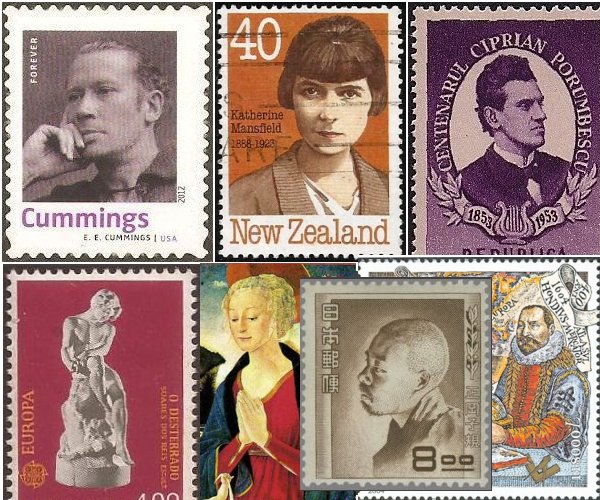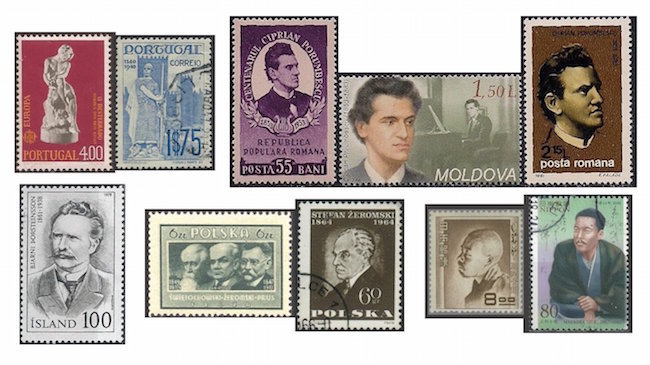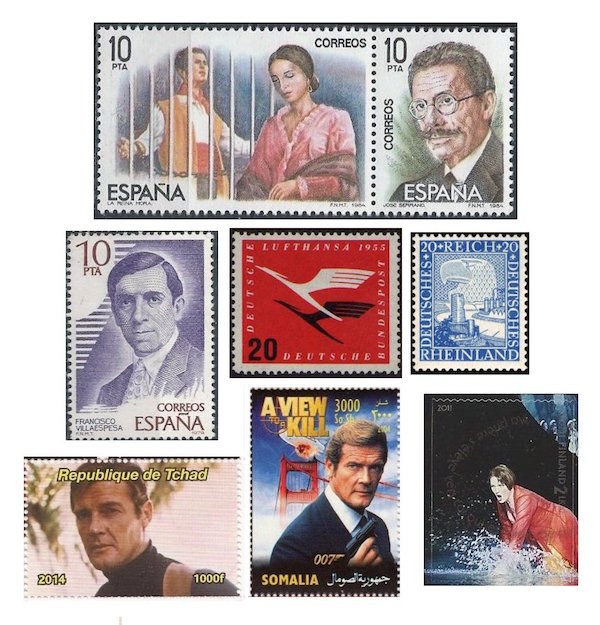The Arts on Stamps of the World —October 14
An Arts Fuse regular feature: the arts on stamps of the world.

By Doug Briscoe
Two writers, one of poems, the other of short stories, dominate today’s proceedings. E. E. Cummings and Katherine Mansfield are followed by four early masters of painting, poetry, music, and cartography, then a variety of creative spirits from the 19th and 20th centuries.
First off, there is no authority (I find) for rendering the great poet’s name in lower case. E. E. Cummings (October 14, 1894 – September 3, 1962) used both versions himself, but most frequently capitalized his signature. Edward Estlin Cummings was the son of a distinguished Unitarian minister and Harvard professor. Cummings began writing poetry on a daily basis when he was 8. After being graduated from Harvard, he worked for a book dealer and, together with his friend John Dos Passos, joined an ambulance corps when the United States entered World War I. Both writers freely expressed their anti-war opinions, and Cummings and another friend, William Slater Brown, were arrested by the French military and held under detention for 3½ months. Only when Cummings’ father wrote a letter to President Wilson was the young man freed. (Brown had to wait two more months.) The experience was grist for Cummings’s literary mill, as he incorporated it into a novel, The Enormous Room (1922), greatly admired by F. Scott Fitzgerald. Cummings had fallen in love with Paris and would revisit the city frequently. His first poetry collection, Tulips and Chimneys, came out in 1923, and the second, XLI Poems (1925), established him as an important avant garde poet. Ultimately, Cummings would produce nearly 3,000 poems, along with two novels and four plays. I was sorry to learn that he was a strong supporter of Joseph McCarthy. His words have been set by a veritable Who’s Who of American composers: Aaron Copland, Leonard Bernstein, John Cage, Ned Rorem, David Diamond, Peter Schickele, Dominic Argento, Vincent Persichetti, Tobias Picker, James Yannatos, and many more. Cummings was one of the poets chosen for a set of ten stamps issued in 2012. I offer a link to a sketched self-portrait made about 1920.
New Zealand short story writer Katherine Mansfield (née Kathleen Mansfield Beauchamp; 14 October 1888 – 9 January 1923) had some of her work published in her homeland before resettling in the UK in 1908. (She had gone to school in London with her sisters from 1903.) Part of her reason for leaving New Zealand was the oppression of the Maori people. Among her numerous amours with members of both sexes was a relationship, her first, with a young Maori woman named Maata who would appear in some of Mansfield’s stories. In England she became friendly with D.H. Lawrence and Virginia Woolf. Mansfield’s most industrious period of writing began in 1916, even though she was diagnosed with extrapulmonary tuberculosis the next year. She found occasion to be twice married (with simultaneous love affairs) before her death at age 34. She was also an able cellist.

The Florentine painter Alesso Baldovinetti (14 October 1425 – 29 August 1499) was the son of a wealthy merchant. His Madonna and Child (1470) has been reproduced on stamps of Dahomey and Somalia. One of Baldovinetti’s pupils was Domenico Ghirlandaio.
There is no stamp honoring Franco-Flemish composer Jacques (or Jacob) Arcadelt (c.?1507 – 14 October 1568), but in the famous Caravaggio painting The Lute Player (c1595), the performer has before him a score by Arcadelt. We saw a couple of stamps, one from Albania, one from Panama, reproducing this image on the painter’s birthday last month, and here are two more, from the USSR and St. Vincent. Arcadelt was a pioneer, and a prolific one, in the writing of madrigals, over 200 of them. He learned about the form from Philippe Verdelot, who is said to have composed the earliest madrigals to bear the name, and Arcadelt’s first book of madrigals was the single most frequently printed music collection in the period, going into 45 editions. He went to Florence, where he met Verdelot, as a young man and some time around 1538 went to Rome, there joining the Sistine Chapel and becoming magister puerorum. It was in 1538 that he produced not only his first madrigal collection but three further books of them. He met Michelangelo, probably in 1542, and set two of his sonnets. In 1551 he returned to France, where he turned from the madrigal to the chanson. He became a member of the royal chapel under Henry II and Charles IX and published a book of masses in 1557. In Gargantua and Pantagruel, Rabelais placed Arcadelt with Clément Janequin and Claudin de Sermisy singing a ribald song.
Our next subject is the cartographer Jodocus Hondius the Elder ( = Joost de Hondt; 14 October 1563 – 12 February 1612). He republished the work of his predecessor Gerard Mercator (with whom he is paired on the stamp) in addition to creating his own early maps of the New World and Europe. At 21 Hondius left Flanders to escape religious persecution and moved to London, where he met Sir Francis Drake, whose portrait he may have painted. Drake had circumnavigated the globe in the 1570s, and Hondius made a map of the bay of New Albion, the site of Drake’s landing in California. (This should not be confused with the later colony of New Albion on the east coast.) In 1593 Hondius settled Amsterdam, where in 1604 he acquired Mercator’s old plates and republished them with three dozen newer maps, several of them of his own making. Hondius cited Mercator as sole author, listing himself merely as the publisher. One last connection: it is believed that the globe seen in Vermeer’s famous painting The Astronomer (1668), as partly reproduced on a stamp from Mozambique, was based on one made by Hondius.
French painter Adolphe Monticelli (October 14, 1824 – June 29, 1886) gets mixed reviews, to put it mildly. Writing in The Guardian in 2005, Sir Timothy Clifford, director general of the National Galleries of Scotland, described Monticelli’s work as “screamingly awful”; one piece, A Garden Fête (c1870-72), came in for especial abuse: Sir Timothy called it the worst painting in Britain, adding: “I call this one a Fete Worse Than Death.” But Monticelli, of the generation just prior to the Impressionists, had his admirers and followers, including Cézanne and Van Gogh, who emulated him to the extent that he declared, “I sometimes think I am really continuing that man.” Monticelli was born in Marseille and studied in Paris under Paul Delaroche. In the 1850s he became friendly with Narcisse Diaz and in the 1860s with Cézanne, both of whom (sequentially) would join Monticelli in al fresco painting. Monticelli’s own style derived ultimately (and decidedly as seen through his own prism) from Watteau and Delacroix. After 1870, he returned to his home town of Marseille, producing many canvases but selling them for a pittance and living in poverty. After his death Van Gogh and his brother Theo helped see through publication a book about him. In 2009 the Republic of Guinea released two sheets devoted to Monticelli, one showing his Self-Portrait against the orientalist Algiers (1876). The other sheet produces no fewer than eight works, of which I show three, including the above-mentioned alleged abomination A Garden Fête, which can barely be seen in this image, and maybe that’s just as well. Prettier things, to my way of thinking, are the Flower Still Life of 1875 and Paysage marin près de Marseille (undated).
From painting we move to sculpture and the Portuguese artist António Soares dos Reis (14 October 1847 – 16 February 1889). On completing his studies in 1867 he proceeded to the École des Beaux-Arts in Paris, earning several prizes, and then to Rome. While in the Eternal City in 1871-72 he carved his masterpiece, O Desterrado (The Exiled). Another of his works reproduced on stamps is his statue of King Alfonso I. (1882). Soares dos Reis received little appreciation or encouragement during his life and committed suicide at the age of 41.

Ciprian Porumbescu (1853 – June 6, 1883) was a Romanian composer born in a part of Bukovina that today is in Ukraine. After studies in Suceava and Cernăuți, he went to the Vienna Conservatory for further instruction under Bruckner. As a supporter of the struggle for Romanian independence he was arrested by the Austro-Hungarian authorities in 1877. Although found not guilty and released, he had contracted tuberculosis, from which he died a few years later, aged 29. The town where he died, Stupca, was renamed Ciprian Porumbescu in his honor. Most of his music is choral and operetta, but his best known work is his Ballad for Violin and Orchestra (1880), and he wrote the music to “Himni i Flamurit” (Hymn to the Flag), which has been used (with new text) as the national anthem of Albania since 1912.
Icelandic folksong collector and hymnist Bjarni Thorsteinsson (Þorsteinsson) (1861 – 2 August 1938) served as pastor of the parish of Hvanneyri-Siglufirði for 47 years. He edited and published an Icelandic Psalm Songbook around the turn of the century. Some of the hymns he wrote were based on melodies from Mozart’s Magic Flute and Weber’s Der Freischütz. A song festival in Þorsteinsson’s name is held each year in July.
The Polish novelist Stefan Żeromski (14 October 1864 – 20 November 1925) has been called the “conscience of Polish literature”. The earlier of the two stamps groups him with two other Polish writers, Alexander Świętochowski and Bolesław Prus, who, ironically, rather disliked Żeromski’s writing and disapproved of his marriage, although later, Prus would provide assistance to the struggling young couple. As it turns out, Prus may have been right, as Żeromski left his wife in 1913 and took up with the painter Anna Zawadzka (1888-1983), with whom he had a daughter, though they were never married. Żeromski, who got a stamp all to himself for his centenary in 1964, was nominated four times for the Nobel Prize. His works include the novels The Labors of Sisyphus (Syzyfowe prace, 1897), a story of the enforced Russianization of Poland, and Ashes (Popioły, 1902-03), which was made into a 1965 film by Andrzej Wajda (not to be confused with the same director’s Ashes and Diamonds of 1958).
Japanese poet Masaoka Shiki (October 14, 1867 – September 19, 1902), especially associated with haiku, was born in Matsuyama City to a family of the samurai class. His family name was originally Tsunenori, but his long sufferings from tuberculosis led him to adopt the name Shiki, meaning “cuckoo”—in Japanese tradition the cuckoo coughs blood as it sings. As a teenager Shiki loved playing beisubaru (we know it as baseball) and was a fellow student of the future novelist Natsume Sōseki. Besides his prominence in haiku—indeed, some see Shiki as one of four great masters of the form—he wrote in other poetic genres as well as prose: criticism, autobiography, and essays. He also has two stamps, one from 1949, the other from 2002.
Josep Serrano i Simeon (or José Serrano Simeón; 1873 – 8 March 1941) was born in Sueca, Valencia, where his father directed the municipal band. He furthered his studies in Madrid, where he became friends with Ruperto Chapí. Between 1900 and 1905 alone he wrote 18 zarzuelas. In this pair of stamps from a series of zarzuela composers released by Spain from 1982 to 1984, his portrait is juxtaposed with a scene from La reina mora (1903).

Our next artist was also a Spaniard, but a writer: Francisco Villaespesa (October 14, 1877 – April 9, 1936). His origin in the province of Almería made its influence deeply felt in all his work, which consists of more than fifty volumes of poetry. His earliest works are the romantic Intimidades (1898) and Luchas (1899). Soon he adopted a more Modernist style with La copa del Rey Thule (1900), then an orientalist one with his pieces from about 1906 on.
Also born on this date was the German architect and graphic artist Otto Firle (14 October 1889 – 4 July 1966). In the First World War Firle had been a pilot, so perhaps it is not altogether surprising that his graphical and aeronautical skills should combine in the original 1918 logo for Lufthansa. A version of this appears on a German stamp of 1955. Firle in 1920 also created the emblem for the German National Railway (Deutsche Reichsbahn) and the very similar one for the postal service (Deutsche Reichspost from 1866 to 1945). One of his own stamp designs was the one for the Rhineland issue (1925)—the blue stamp to the right of the Lufthansa issue. As for architecture, Firle’s best known buildings include the Nordstern Life Insurance Administration Building in Berlin (1935-36). From 1946 to 1949 Firle taught at the Berlin Technical High School, thereafter acting as a freelance architect.
The late English actor Roger Moore (14 October 1927 – 23 May 2017) would have turned 90 today had he not passed on last May. He got into acting when his policeman father was investigating a robbery at the home of director Brian Desmond Hurst. Hurst met 18-year-old Roger and seemed to think he had a good face for the movies. Moore appeared as an extra in Caesar and Cleopatra (1945) and was on his way, but not straight to the top. That took a while. Hurst paid the fees for Moore’s attendance at the Royal Dramatic Academy of Art, where one of his fellow students was Lois Maxwell, the future “Miss Moneypenny” to Moore’s (and Connery’s) 007. In 1952 Moore went to Hollywood and appeared as a recurring character on the popular TV series Maverick with James Garner. (Oddly enough, the part had been offered to Sean Connery, who turned it down.) Moore had a hit as Simon Templar in the series The Saint from 1962 to 1969 and graduated to James Bond in 1973. He would play the part in seven Bond films up to 1985. (Another curiosity: Moore had played Bond in a 1964 episode of the British comedy show Mainly Millicent with Millicent Martin.) Roger Moore was made a UNICEF Goodwill Ambassador in 1991 and received a knighthood in 2003 for his services to charity.
Contemporary Finnish composer Kaija Saariaho turns 65 today (born 14 October 1952). She herself has not yet been honored on a postage stamp, but her opera L’Amour de loin (2000), which had its Metropolitan Opera première last December, is represented on a sheet of four stamps commemorating the Finnish National Opera. The work has also been recorded and can be found on Harmonia Mundi CDs, with Kent Nagano conducting, and on a Deutshe Grammophon DVD under Esa-Pekka Salonen.
A graduate of the University of Massachusetts with a B.A. in English, Doug Briscoe worked in Boston classical music radio, at WCRB, WGBH, and WBUR, for about 25 years, beginning in 1977. He has the curious distinction of having succeeded Robert J. Lurtsema twice, first as host of WGBH’s weekday morning classical music program in 1993, then as host of the weekend program when Robert J.’s health failed in 2000. Doug also wrote liner notes for several of the late Gunther Schuller’s GM Recordings releases as well as program notes for the Boston Classical Orchestra. For the past few years he’s been posting a Facebook “blog” of classical music on stamps of the world, which has now been expanded to encompass all the arts for The Arts Fuse.
